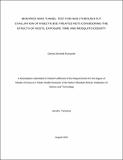Modified who tunnel test for high through put evaluation of insecticide-treated nets considering the effects of hosts, exposure time and mosquito density
Abstract
The standard World Health Organization (WHO) tunnel test is a reliable laboratory bioassay used
for "free flying" testing of Insecticide Treated Net (ITN) bio-efficacy. Multiple parameters affect
the outcomes measured in tunnel tests. Therefore, a comparison of hosts, exposure time, and
mosquito density against the current gold standard test (100 mosquitoes, animal bait and 12-hours
exposure) was conducted following ITNs evaluation guidelines. A series of experiments were
conducted in the WHO tunnel bioassay to evaluate the bio-efficacy endpoints, mortality at 24-
hours (M24) and 72-hours (M72), blood feeding success (BFS), and blood feeding inhibition
(BFI). The following parameters were evaluated: 1) baits (rabbit, membrane, human arm), 2)
exposure time in the tunnel (1-hours vs 12-hours), and 3) mosquito density (50 vs 100 mosquitoes
per test). Finally, an alternative bioassay using a membrane with 50 mosquitoes was compared to
the gold standard bioassay. Resistant Anopheles arabiensis and susceptible Anopheles
gambiae were used to evaluate Interceptor®
and Interceptor®G2 ITNs. Similar trends in mortality
and BFI were observed for both ITNs using the gold standard WHO tunnel test or alternative
bioassays. Mortality and BFS were not statistically different when rabbits were the bait or when
50 or 100 mosquitoes of either strains used. No systematic difference was observed for the
agreement by Bland and Altman's methods (B&A) with a mean difference 4.54% in blood feeding
and 1.71% for M72. When comparing membrane with 50 mosquitoes and rabbit with 100
mosquito, no systematic difference was observed for the agreement with mean difference 9.06%
for blood feeding and -5.44% for M72. These results demonstrate that WHO tunnel tests using
rabbit bait run with 50 mosquitos’ measures similar outcome compared to gold standard bioassay.
In addition, using a membrane feeder with 50 mosquitoes is a potential replacement for the WHO
tunnel bioassay with animal bait and merits further studies at other laboratories to corroborate
these findings.

